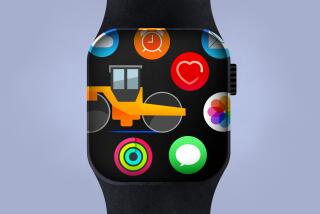New book explores how Jony Ive created Apple’s greatest products
When you hold an iPhone or an iPad, the simplicity of the design can be deceptive. That’s because simple does not mean easy.
A new biography of Apple’s design guru Jony Ive makes it plain just how tedious and laborious the design process can be that results in the sublime look and feel of products that have made the company an international obsession.
PHOTOS: Apple’s new Mavericks OS X: Top 10 features to check out
The book, which went on sale last week, is “Jony Ive: The Genius Behind Apple’s Greatest Products,” by Leander Kahney. As editor and publisher of the blog CultofMac.com, Kahney has covered Apple for more than a decade and written a previous book about Steve Jobs.
Kahney said he began thinking about Ive’s role at Apple not long after Jobs died two years ago. Ive had already developed a reputation as one of the world’s leading designers for his role in a string of products such as the iMac, iPad and iPhone, all of which helped make Apple the most valuable company in the world.
“After Jobs’ death, it was becoming more and more obvious that he was the creative prime mover at Apple,” Kahney said in an interview. “I think of all the characters at Apple, he’s the most important.”
Knowing Apple and Ive would never cooperate with such a book, Kahney had his work cut out for him. But in getting some former Ive and Apple colleagues to talk, he’s put together a fascinating portrait of what makes both Ive and Apple unique.
It’s not an easy story to tell. Ive’s life story lacks the drama and, well, weirdness of Jobs’ life. No acid trips. No fruitarian diets. No great career setbacks.
Ive’s father was a leader in crafting curriculum for Britain’s industrial design and education programs. Ive essentially followed his father into the family business, and his genius was recognized early on, both at school and then professionally.
Ive made his way from London to California and then was hired at Apple before Jobs returned. But when Jobs did come back, he made a philosophical decision that would set the tone for nearly everything that Apple has done since.
Rather than put engineering or marketing in charge of developing products, Jobs placed a small team of designers, eventually led by Ive, in charge. The driving ethic then became not cost or sales or profits, but striving toward perfection in design.
Now, if you hear the word “design,” and think that Ive and his team are just sitting around sketching ideas in a notebook all day, think again.
Apple’s designers start with a notion of what they think a product should make you feel. From there, they figure out everything from what components go inside, what functions it will perform, what materials it requires, as well as the look and feel.
“They’re the primary engineers,” Kahney said. “It’s like this little R&D factory inside Apple. It’s not just the look that they create, but how the products work.”
Instead of handing this work off to engineers, the designers will spend months, sometimes year, looking for just the right material, ball bearings, colors, or whatever, that create the effect they want.
They create endless models by hand and then by machine. And eventually, the models are re-crafted over and over, with sometimes only tiny adjustments to each version.
Once a product is finalized, it moves to the manufacturing process, where the design team, including Ive, might spend weeks or months at a factory in Asia helping to develop the production process. That could include having to figure out just the right manufacturing techniques that will produce a particular color on an iMac or iPhone that provides a solid finish without cracking.
Ive may be a design god, but his genius, and his teams’ success, lies as much with an ability to focus and relentlessly tinker in a quest for perfection.
“The insane amount of work they put into this stuff,” Kahney said. “It really is mind-boggling how they sweat the tiniest details.”
The question now is this: In the post-Jobs Apple, how much influence does Ive still have? For the moment, the answers appears to be a lot. Last year, in a management shake-up, Ive was promoted to senior vice president of design, giving him authority over hardware and software design.
Kahney’s book raises another bigger issue going forward. While all the top executives have played vital roles in Apple’s success, Ive may be irreplaceable. The way he has managed and structured the design team at Apple makes it a hard act for anyone else to follow.
The good news for Apple and its fans, however, is that Ive appears to be content to stick around the company where he has churned out a steady stream of iconic products. And, in turn, it appears Apple Chief Executive Tim Cook is happy to give Ive and his group the autonomy within the company that has allowed them to thrive.
“They operate very much like a small, outside design consultancy,” Kahney said. “That’s one of the keys to their success and the constant innovation that comes out of there.”
ALSO:
Google Glass will soon be able to play music
Apple says iPad mini with retina display on sale now
IPhone, iPad beat game consoles as teens’ preferred gift, survey says







